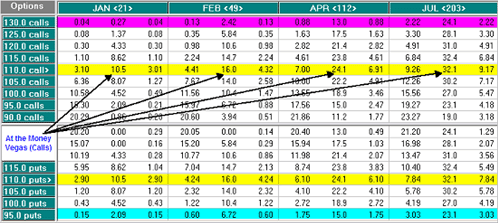
Greeks is a way to measure options price sensitivity to quantifiable factors. Greeks include Delta, Gamma, Vega, Theta and Rho. Armed with options Greeks traders are empowered to make informed decision on which options to buy and sell, as well as when to trade. Greeks are calculated with the help of hypothetical options pricing model.
Option Greeks in detail
Delta
Delta is the first Greek, which helps to gauge the possibility of price adjustment of the considered option per $1 change as expiration approaches. For example, Delta of 0.50 means the underlying options price will hypothetically move to $0.50 for every $1 price movement. It has 50% chances of being in money during expiration.
- Call options have +ve deltas
- Put option have -ve deltas
- At-the-money option deltas are around 50
- In-the-money option, delta is 80 or more
- Out-of-money option, delta is meagre 20 or less
Gamma
Gamma measures the change rate in Delta, when option price moves upwards or downwards. You can think Delta as speed & Gammas as acceleration.
Let’s understand the relationship of Delta and Gamma
The accuracy of Delta is up to a specific price and time. Let’s understand the above example where the stock moves to $1 and option consequently moves to $0.50. This $1 move caused a call option towards deep-in-the-money, so Delta moves closer to 1.00. Let’s assume Delta is now 0.65. The change from 0.50 to 0.65 is the option’s Gamma.
Teta
Theta measures option’s price change for one-day reduce in time and expiration. In other words, Theta defines how much price of the stock need to decrease as it nears expiration. Remember options lose their value as expiration time approaches. Theta evaluates how much option value gets cut everyday, if other aspects remain the same. Time decay is not the same. In-the-money and out-of-money options Theta increases with the approach of expiration but for out-of-the-money option it decreases.
Vega
Vega measures the price change due to fluctuation in implied volatility of considered stock. Ignoring Vega causes you to overpay, while buying options. Drop in Vega causes call and put positions to lose value. A rise in Vega causes both positions to gain value.
Rho
Rho measures expected option price changes of an underlying stock due to changes in interest rates. Increase in interest rates increases call options and decreases put options. In general, Rho is considered only when the interest rates anticipate any changes. With an increase in interest rates the difference between put and call positions of the underlying stock, whose strike price is equidistant will get wider. Alternatively, low interest rates mean difference will be small.
Implied Volatility
Implied volatility is closely related to Greek. It is based on underlying options quoted price. An IV estimates how stocks price may fluctuate in future. Higher than normal IVs are more favourable for selling and lower-than-normal IVs are preferable for buying because volatility frequently slips back towards its mean in future.
With a clear understanding of Greek basics, you can start applying it to your existing strategies.














